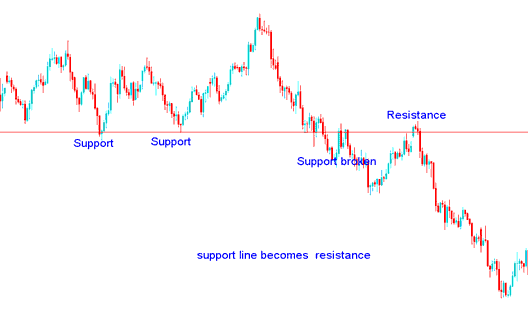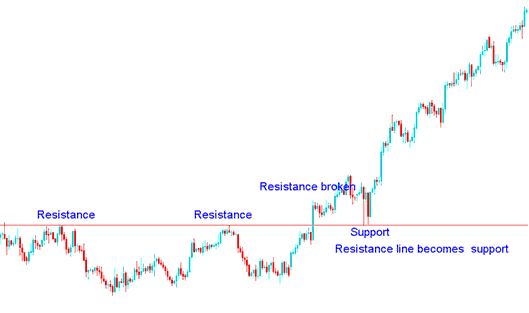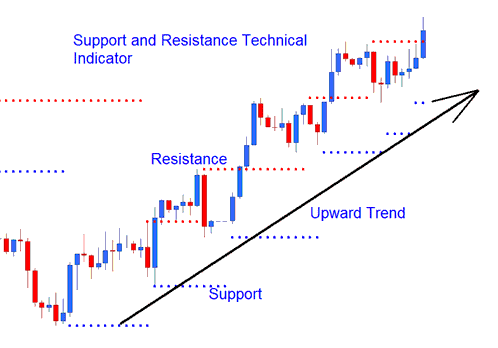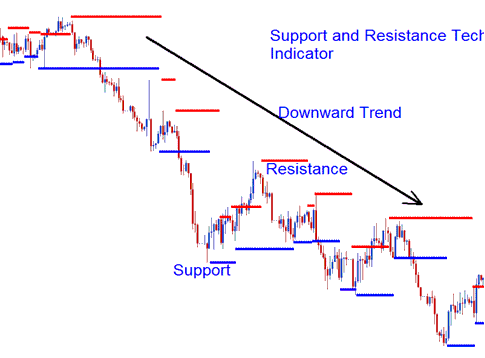How to Use Support and Resistance to Trade Forex
How to Analyze when a Support Level or Resistance Level is broken - In forex technical analysis, When a support level is broken it becomes a resistance level and When a resistance level is broken it becomes a support level.
In the above previous lesson trades examples we have looked at support and resistance levels that were not broken. These points of support and resistance held because they were strong enough.
However, sometimes support and resistances levels are not strong enough to stop movement of the price moving in a certain direction. When price moves past these support and resistance points we say that these levels have been broken. That is why we always use a stop loss order when trading these levels, just in case these levels do not hold.
But what happens when these support and resistance levels are broken, well the levels change one to the other, for example
- When a support is broken it becomes a resistance level
- When a resistance is broken it becomes a support level
Using Forex Charts, The Examples Below Show an Illustration of What Happens When These Support and Resistance Levels Break:
Support Level is broken it becomes a Resistance Level
In the example below, using the GBPUSD chart, the support level that had been tested two times could not hold the third time, the sellers were able to push the price down past this support level.
However, the forex price bounced back up again, but this time the price could not go up beyond this line. The price was there after quickly pushed down by the sellers. This was because the line that was a support level had now turned into a resistance level.
In Forex trading when a support is taken out, the stop losses placed below that level are also taken out, thus reducing the momentum that the forex buyers had. This give forex sellers an opportunity to short sell the currency & place their stops just above this level which now turns into a resistance level.

Resistance Level is broken it becomes a Support Level
In the forex trading example below using the EURUSD chart, the resistance level that had been tested two times could not hold the third time, the forex bulls were able to push the forex price up past this resistance level.
When the forex price tried to go down again it could not go lower than this level. The forex price was there after quickly pushed further upwards by the forex buyers. This was because the line that was a resistance level had now turned into a support level. This is what happens in Forex trading or stocks trading, when a resistance level is broken it turns into a support level.

Traders who had closed their short sell trades will now open long trades & place their stop losses just below this level.
Major and Minor Resistance Levels
In Forex currency charts the resistance levels and support levels formed are either major resistance/support levels or minor resistance/support levels.
Major Resistance/Support levels
In Major Resistance/Support levels price will stay at this level for some time, either the forex price will consolidate at these major support and resistance levels or form a rectangle consolidation chart pattern when price gets to this point. A major support or resistance level will be tested several times before it is either broken or it holds and the forex price does not get to move past this resistance/support level.
The above forex trading examples are good example of major Resistance and Support Levels.
Minor Resistance/Support levels
In minor resistance and support levels the FX price will quickly form these points in the short term and the price also moves quickly past these resistance & support areas.
Upwards Forex Trading Trend: The pattern of these minor resistance and support levels will form a series of levels whose general direction is upwards.
Upwards Trend Series of Support and Resistance in Forex Up Trend
Downwards Forex Trend: The pattern of these minor resistance and support levels will form a series of levels whose general direction is downwards.

Downwards Trend Series of Support and Resistance Levels in Forex Down Trend
